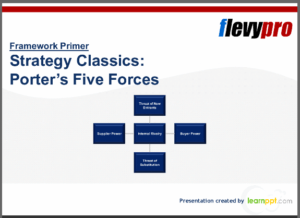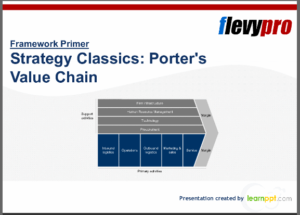Michael Porter, top Harvard Business School Professor and one of the most well-known long time strategy experts in the world, spoke at the PMO Symposium by the Project Management Institute (PMI) a few years ago. You can watch the one-hour video here: Michael Porter on Aligning Strategy and Project Management.
This post explores the key points Michael Porter made in that address. The main point in part is that it pays for project and program managers to have a good understanding of strategy. Indeed, organizational success depends on continuous dialog between implementers and strategists – which can only take place if all have a firm grasp of strategy.
On Misconceptions About Strategy
 Porter observes that many people have the impression that strategy is provided by upper management in a top down fashion. Porter asserts that upper management frequently does not have the skills to communicate the strategy well, and that the top down approach is better replaced with a continuous dialog to assure an understanding flavored by experience at various levels.
Porter observes that many people have the impression that strategy is provided by upper management in a top down fashion. Porter asserts that upper management frequently does not have the skills to communicate the strategy well, and that the top down approach is better replaced with a continuous dialog to assure an understanding flavored by experience at various levels.
Strategy, as distinct from project management, is thinking about the whole, and not just the project or the function. How does the whole company fit together…and how does it fit into its ecosystem? How does it respond to external circumstances?
Businesses often misconstrue the whole idea of strategy and default to the idea of simply being the best in the business. There is an assumption – one that often is wrong – that if the company becomes the best, it will be successful.
The reality is that different results can come out of “being the best”, all depending on the situation. Porter asserts that, for example, there is no best auto company. It all depends on who the car is meant to serve. It depends on the needs of the customer. Indeed, there are multiple successful car company serving different customer needs – usually to the exclusion of other customer needs. Strategy involves making choices and tradeoffs – not simply being the best.
There is no one way to compete. The strategist’s job is to figure out how to deliver unique value to customers the company chooses to serve. As in the auto industry, a company in any industry cannot meet the needs of every customer. Therefore, strategy is about competing to be unique in some way.
Another misconception is to confuse strategy with a goal. In contrast with goals, strategy is more about how – about the set of choices the company makes that will give it the competitive advantage needed to achieve the goal. Strategy is more holistic; it’s not about any single action. Actions flow out of strategy. Typically, it is a series of action steps…which are implemented by projects and programs.
You can get right to the core of Michael Porter’s thinking in his two seminal books, “Competitive Strategy” and “Competitive Advantage“, as well as “Understanding Michael Porter” by Joan Magretta.
And of course there are more excellent Michael Porter books.
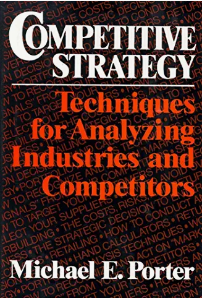 |
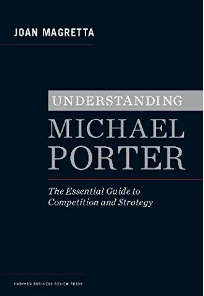 |
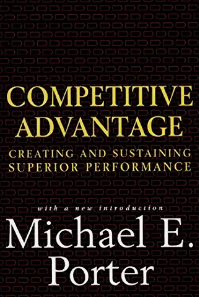 |
There is a need to approach strategy differently – in a more positive way. The question to ask – by both strategists and project managers – is, “Where do we want to end up relative to competitors?”
On Business (Not Corporate) Strategy
 Porter continues down the line of reasoning that strategy is holistic, is specific about choices about how to compete, and is about positioning. Porter distinguishes between the strategy of a specific business, versus a portfolio of businesses, as a large corporation might have. His focus is on business, not corporate, strategy.
Porter continues down the line of reasoning that strategy is holistic, is specific about choices about how to compete, and is about positioning. Porter distinguishes between the strategy of a specific business, versus a portfolio of businesses, as a large corporation might have. His focus is on business, not corporate, strategy.
With a business, there are two basic considerations in making the choices:
- Industry structure – The nature of the business, the degree of change happening, the inherent profitability, and the external environment, or industry ecosystem. He talks about his Five Forces Framework, which depicts how competition takes place through industry forces, how industry rivalry evolves, and how companies can even be effected by indirect rivals.
- Positioning – How the organization will decide to compete within the industry to gain competitive advantage. The question is, “Where do you want to be?” The answer to that question determines the priorities on projects and programs
In thinking about profitability, Porter distinguishes between the profitability of a business attributed to general industry profitability, and the profitability that relates to the advantages over other competitors based on competitive advantage.
The key points he emphasizes are that everyone, no matter what function, needs to understand the ways in which projects and programs can extend the desired or established competitive advantage of the company. There needs to be an ability across the organization to have a continuous dialog between strategy and project management. That requires that everyone understands the greater concept of strategy.
—————————————-
Do you need some professional slides for a presentation on this or related strategic topics? I suggest the flevy Marketplace for Business Best Practices, and consider these particular Michael Porter documents:
| Strategy Classics: Porter’s Five Forces (28-slide ppt) – $25 | Strategy Classics: Porter’s Value Chain (23-slide ppt) – $25 |
—————————————-
Two Basic Approaches to Strategy
 Porter goes on to simplify strategy by isolating two basic approaches to positioning for superior performance and greater profit:
Porter goes on to simplify strategy by isolating two basic approaches to positioning for superior performance and greater profit:
- Provide greater value to command a higher price
- Become inherently more efficient to achieve a lower cost
It’s either higher prices or lower costs. Porter asserts that rarely can a business do both.
From that simple explanation, strategy can get a bit more complicated. There are many ways to provide greater value as a differentiator, or to become more efficient while maintaining an adequate level of quality. So how can businesses achieve competitive advantage in one of these two ways?
It’s by using the next of Porter’s well-known tools, the “value chain” – see my post Creating Value Chain Advantage: A Project’s Purpose for details. The value chain provides the framework for achieving advantage. Here are the two key things Porter says the value chain can do for a business:
- Takes a systems view of the business
- Portrays the business as a set of activities
Everyone in a business is somewhere in that business’ value chain. Every participates in adding value for the customer in some way. Here are some examples of value chain activities:
- After sales service
- Product development
- Packaging
- Assembling
There are myriads of activities in the value chain. Porter asserts that companies can build competitive advantage anywhere in the value chain. However, it is more difficult for a competitor to copy if competitive advantage is built on a unique combination of activities, especially if those activities are interconnected.
Porter’s discussion then turned to how, more specifically, organizations can gain competitive advantage.
—————————————-
Do you need some professional slides for a presentation on this or related strategic topics? I suggest the flevy Marketplace for Business Best Practices, and consider these particular Michael Porter documents:
| Strategy Classics: Porter’s Five Forces (28-slide ppt) – $25 | Strategy Classics: Porter’s Value Chain (23-slide ppt) – $25 |
—————————————-
Two Ways to Gain Competitive Advantage
 First, Porter notes that building and enhancing competitive advantage is done through projects and programs.
First, Porter notes that building and enhancing competitive advantage is done through projects and programs.
Porter outlines two types of projects:
- Operational effectiveness
- Choosing to do things differently
Operational effectiveness is all about best practices. For example, companies in many industries can operate more effectively by implementing an Enterprise Resources Planning (ERP) system. Many projects involve implementing an ERP system, and they can save money and make businesses more efficient.
However, implementing a “best practice” such as an ERP system, is not really strategic and does not really differentiate the company from competitors. Best practices advance everyone that implements them, but leaves them with little or no competitive advantage…and leaves everyone else behind. Best practices can keep your company in the game so that it can implement some real strategic differentiators.
—————————————-
I recommend these PM templates (paid link):
—————————————-
That’s where choosing to do things differently comes in. That’s what real strategy is. It is about focusing on unique positioning – or developing a unique value proposition.
Porter outlines three parts to a unique value proposition:
- What customers are you serving? Who are we going after…and who not?
- What specific needs of those customers are we trying to meet? Is it all the needs…or a subset?
- How do the answers to these first two questions translate to the pricing we want?
The key is that the company needs to answer these questions differently – uniquely – from all other competitors. The idea is to engineer a distinctive value chain to deliver to customers.
Porter emphasizes the idea of tradeoffs – the idea that you choose to be good at one thing, and at the same time choose to not be good at another. He summarizes that strategy is fundamentally about choice:
- Who to create value for
- How to configure the business to deliver that value
- How to choose tradeoffs about who not to serve
These choices are unique, and not about doing the same things as other competitors. They also need to be self-reinforcing – through continuous and consistent execution. That means consistency across operations…and projects.
—————————————-
Do you need some professional slides for a presentation on this or related strategic topics? I suggest the flevy Marketplace for Business Best Practices, and consider these particular Michael Porter documents:
| Strategy Classics: Porter’s Five Forces (28-slide ppt) – $25 | Strategy Classics: Porter’s Value Chain (23-slide ppt) – $25 |
—————————————-
Final Points From Michael Porter
Porter made some final points to tie it all together.
- If the benefits of strategy are going to be realized, strategy cannot be a secret. Strategy should not be confidential – as may be appropriate for technologies.
- Today, the ideas around the strategy need to be widely circulated, transparent, and repeated often.
- Project managers – not just senor managers – need to have a strong concept for strategy.
- Project managers and strategists need to distinguish between operational improvements driven by best practices and strategic initiatives that do things differently.
Porter says that strategy is tested every day. Metrics need to inform, and the ability to adjust must be considered.
—————————————-
The following are my three favorite Michael Porter books (paid links, also pictured below):
- “Competitive Strategy: Techniques for Analyzing Industries and Competitors“, by Michael Porter
- “Understanding Michael Porter: The Essential Guide to Competition and Strategy“, by Joan Magretta
- “Competitive Advantage: Creating and Sustaining Superior Performance“, by Michael E. Porter
And of course there are more excellent Michael Porter books.
 |
 |
 |
—————————————-
Finally, what project and program managers do is embedded in strategy. It is critical to understand the big impact of the project that you, as a project manager, are running. Project managers cannot be passive recipients of top down guidance. Instead, a two-way dialog about strategy is needed on a continuous basis.
What kind of dialog do you have on your projects/programs with upper management? Is it strategic?
For a deep dive into Michael Porter’s thinking, see his two seminal books, “Competitive Strategy” and “Competitive Advantage“. I also recommend a shorter and well written book, “Understanding Michael Porter“, by Joan Magretta.
—————————————-
I recommend these strategy resources (paid link):
—————————————-
